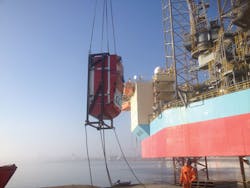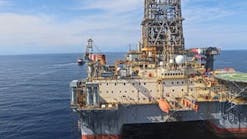Enclosed solids control system lowers mud consumption, boosts drilling efficiency
Brandon Buzarde
Cubility AS
In a time of low oil prices, the quality of drilling fluids and the accompanying amounts of drilling waste generated represent important cost and efficiency issues.
With theglobal drilling fluids market expected to reach nearly $15 billion by 2020 (according to analyst Grand View Research), improving the quality of drilling fluids and reducing waste can have a major influence on costs.
Such waste consists of the solid cuttings that must be separated from the liquid drilling mud and often ends up in pits or landfills onshore, or - if it meets environmental regulations - is disposed into the ocean.
Yet, how can drilling fluids be optimized to ensure maximum drilling efficiencies on offshore wells and how can there subsequently be a reduction in drilling waste?
Solids control
There’s no doubt that drilling fluids (or muds) play a crucial role in drilling activity and efficiencies today - cooling and lubricating drill bits, carrying drill cuttings to the surface, controlling pressure at the bottom of the well, and ensuring that the formation retains the properties defined for that well.
In North America, the drilling fluids market on its own was valued at $4.3 billion in 2012 by industry analyst Transparency Market Research and is expected to reach $7.2 billion by the end of 2019.
Yet, the effectiveness of drilling fluids and its integrity is highly dependent on the solids control solutions that surround them and their ability to separate the mud from rock particles. Are today’s solid control technologies delivering when it comes to fluid quality and reduced waste?
For many years, the maintaining of drilling fluids and the separation of rock particles was down to shale shakers. Through vibration and high G-forces, solids were filtered out for overboard discharge or for treatment on the rig or onshore. The cleaned mud was then incorporated back into the active fluid system and reused to drill the well.
However, there are limitations to such technologies.
Firstly, the high G-forces used by shale shakers often break the drilled solids down into finer particles, effectively making them more difficult to remove. In turn, a higher solids content affects the drilling fluid’s efficiency by negatively impacting penetration rates and equivalent circulating density.
Secondly, despite the amount of solids content in the mud, vibrating-type shale shakers still often result in high volumes of mud being lost, large amounts of drilling waste generated, and less mud able to be reused within the system.
With the cost of the average oil-based mud used on the Norwegian continental shelf approximately $1,300/cu m ($4,590/cu ft), and the treatment and disposal of drilling waste conservatively estimated to cost $1,580-1,750/ton, this can have a significant effect on the bottom line.
Thirdly, another downside to shale shaker technology is its negative effect on HSE with rig personnel often exposed to high noise levels and vibrations as well as the emission of oil and other vapors.
An alternate approach
It is against this backdrop that Norwegian-based Cubility has developed an alternative to solids control - one that leads to the efficient separation of drilled rock particles from fluids, a reduction in the volumes of mud lost and waste generated, and improved HSE.
The Mudcube system is an enclosed, vacuum-based filtration system. Rather than relying on high G-forces, drilling fluids are vacuumed through a rotating filter belt using high airflow - at 20,000 l (5,283 gal) per minute - to separate the cuttings from the fluid.
The cleaned drilling fluids are then returned to the active mud system. The drilled solids - carried forward on the filter belt - are then discharged either directly overboard (if they meet environmental discharge regulations) or to a cuttings handling system.
The system also has one air-knife installed on the inside of the vertical part of the filter-belt to remove any cuttings that may have stuck to the belt and includes water-knives that are designed to clean the filter belt and improve filtration.
It is these improved levels of solids removal efficiency and two-phase separation of liquids and solids that reduces the volume of drilling fluids lost, minimizes the tonnage of waste generated, and raises drilling fluid integrity performance. The better quality of the fluid also results in enhanced rates of penetration (ROP), reduced stuck pipe incidents, and improved wellbore stability.
In addition, as well as reducing the amount of waste, the reduced percentage of mud on the cuttings can lead to significant costs savings and greater flexibility over disposal.
Finally, the remote, automated operations of the Mudcube and its enclosed system, which features reduced vibration and noise levels and the elimination of oil vapor, improves HSE in drilling operations.
North Sea installations
The technology’s first permanent offshore installation was in 2012, on a drilling rig working off Norway. To date, it has been used to drill more than 40 wells (on- and offshore) in eight countries by 11 operators.
One such offshore installation is theMaersk Giant jackup drilling rig, where three Mudcubes replaced four traditional shale shakers. Since then, Maersk Giant has embarked on several drilling programs in the North Sea, with the system used in the drilling of 13 wells to date.
Operators Talisman Energy Norge AS and DONG E&P Norge AS have seen benefits such as enhanced working conditions and no costly HVAC upgrades to the shaker room; improved drilling efficiencies with less drilling fluid being lost and more returned to the mud tanks for reuse; and a lower mud content in the cuttings, resulting in easier and cheaper disposal. In one selected well, where only 27 metric tons (nearly 30 tons) of drilling fluid waste was generated, the estimated oil on cuttings was just 1 to 5% by weight.
In 2015, Cubility also signed a multi-million dollar deal on theJohan Sverdrup field, one of the most important industrial projects in Norway over the next 50 years.
Production start-up is scheduled for the end of 2019 and will consist of four platforms, on which the Mudcubes will be based. In this case, the system will provide operator Statoil with drilling efficiencies, lower mud consumption, reduced waste volumes, and improved HSE.
While many new technologies must go through incremental stages of adoption, this system is operational today, impacting drilling efficiencies and protecting non-productive time (NPT) in challenging offshore environments, such as the North Sea. Gulf of Mexico installations are also expected soon.
Managing NPT
One of the key measurements when it comes to managing drilling programs and costs is that of NPT. In any drilling program, the operator’s goal is to minimize flat times and maximize drilling time, as it is a huge cost to the industry.
Two such examples where the Mudcube has incurred zero NPT are installations on theMaersk Gallant jackup and the Scarabeo 5 semisubmersible rig.
Maersk Gallant is one of Maersk Drilling’s ultra-harsh environment jackup drilling rigs and is designed for year-round operation in the North Sea. Recent operators that have used Maersk Gallant include Statoil and Total E&P Norge, the latter of which embarked on a new contract in February 2016.
Three of the devices were installed on the rig in 2014, replacing four shale shakers. As of February 2016, the Mudcube has reached cumulative running hours of 14,644. NPT registered due to the new devices was zero.
On theScarabeo 5semisubmersible rig, owned by Saipem, four of these systems were installed in 2013, replacing five shale shakers. The total running-hours of all four is 13,329 hours, with NPT again zero.
To date, no NPT on a rig has ever been reported due to the failure of one of these systems.







